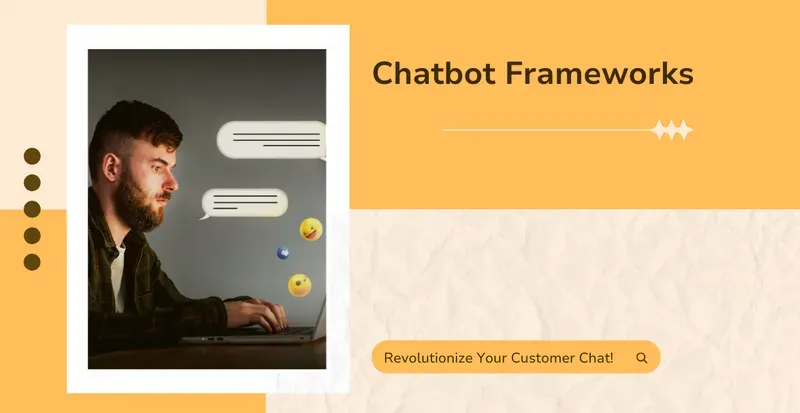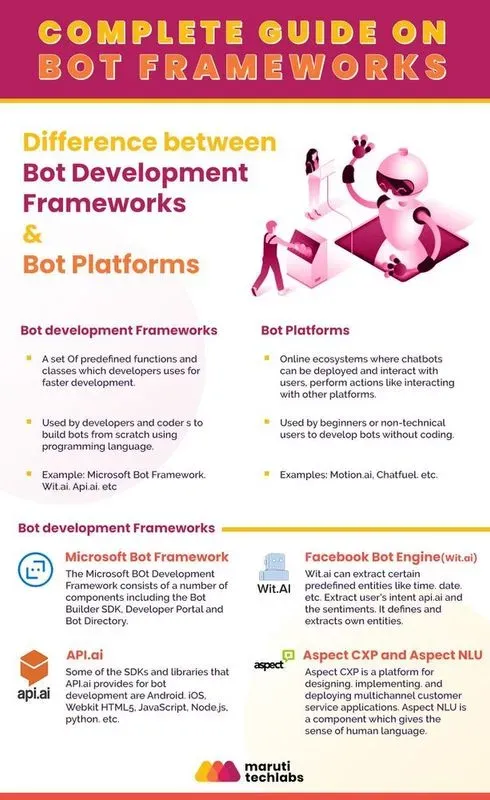Chatbot Frameworks: Revolutionize Your Customer Chat!
By Sonaksh Singh Rawat on

Significant attention has been drawn to chatbots this year, as top technology corporations, including Facebook and Microsoft, have introduced extensive chatbot frameworks that support the broad-scale development of these tools.
More than 11,000 chatbots have been created for Facebook Messenger, with the platform welcoming close to 23,000 developers who have registered for its Bot Engine. Moreover, a variety of startups have come to the forefront, providing their distinct chatbot frameworks and features. Other messaging services, like Telegram and Slack, are also making strides by inaugurating their “Bot Stores” and allocating resources to foster developer engagement.
What are Bot Frameworks?
The Bot or chatbot Framework acts as an essential environment for building bots and outlining their actions. The task of developing bots can appear overwhelming due to the wide range of messaging platforms and Software Development Kits (SDKs) used for chatbot creation. Bot development frameworks are crafted as software frameworks to streamline the development process by reducing the manual work involved in crafting chatbots.
Although many chatbot frameworks claim to offer a “write once deploy anywhere” capability, in practice, developers often end up designing specific chatbots for each messaging platform they wish to engage with.
The components included in the Bot development framework, such as the Bot Builder SDK, Bot Connector, Developer Portal, and Bot Directory, along with an emulator for bot testing. Nonetheless, it is important to highlight that chatbot Framework solutions may not be the most user-friendly for beginners that are keen on learning chatbot development.
Difference between the Bot Frameworks and Bot Platforms?
The distinction between “Bot Framework” and “Bot Platform” often leads to confusion, as these terms are sometimes mistakenly used interchangeably. A Bot Platform provides the foundational environment essential for deploying and executing applications.
In contrast, a chatbot framework is a tool designed to assist in the development and integration of various components within an application, facilitating the construction of chatbots. These platforms serve as online hubs, enabling chatbots to interact with users, perform tasks on their behalf, and establish communication with other platforms.
The Bot Development Framework is equipped with a set of predefined functions and classes, aimed at enhancing the efficiency and speed of coding during the development process.
Bot Platforms are particularly user-friendly for beginners or those without a technical background, offering a way to create bots without needing to code. On the other hand, Bot Development Frameworks cater to developers and programmers, allowing them to build bots from scratch by utilizing specific programming languages.

Some of the Best Bot Frameworks in the Industry
1. Facebook Bot Engine:
In April 2016, the launch of the Facebook Bot Engine, utilizing Wit.ai technology, marked a significant advancement. Wit.ai functions on a standalone cloud server, with the Bot Engine acting as a conduit for integrating bots into the Messenger platform. The focus on enhancing and expanding Messenger is a testament to its broad reach and significance.
The introduction of the Facebook Bot Engine reflects a strategic emphasis on improving the Messenger user experience. This initiative encourages developers to utilize the platform, aiming to enrich Messenger with a wide variety of specialized chatbots that cater to individual user preferences.
The backbone of the Facebook Bot Engine is its Machine Learning component. Developers can feed the system sample conversations, which enables the chatbot framework to handle different versions of similar queries. This feature is crucial for developers, allowing them to continuously refine and develop their chatbots.
Wit.ai offers several essential capabilities for bot development, including:
- The extraction of predefined entities, such as time and date.
- The identification of user intent.
- The analysis of user sentiments.
- The ability to define and extract custom entities.
2. Microsoft Bot Framework
Microsoft announced its chatbot Framework, offering a distinct philosophy and approach compared to its contemporaries like Facebook. The framework includes two pivotal components:
- Bot Connector, which acts as the integration framework.
- LUIS.ai, focused on natural language understanding.
The Microsoft chatbot framework excels in its integration capabilities, compatible with a diverse array of platforms such as Slack, Facebook Messenger, Telegram, Webchat, GroupMe, SMS, email, and Skype. Microsoft also provides a Platform as a Service (PaaS) option through Azure, dedicated to bot development.
This chatbot framework is designed to overcome common challenges in bot development, providing essential functionalities like basic input/output, language and conversation skills, performance, responsiveness, and scalability. It aims to offer users an optimal conversational experience.
Featuring tools for building, connecting, managing, and publishing interactive chatbots that engage naturally on multiple platforms. The Microsoft chatbot Framework includes the Bot Builder SDK, Developer Portal, and Bot Directory, showcasing its comprehensive support for chatbot development.
3. API.ai
API.ai is recognized as a sophisticated web-based chatbot framework, tailored specifically for the development of advanced bots. It uniquely simplifies the typically complex processes of defining entities and intents by providing a comprehensive assortment of domains.
This significantly eases the burden for developers. Additionally, it is compatible with an extensive selection of SDKs and libraries, supporting the creation of bots across various platforms, including Android, iOS, Webkit HTML5, JavaScript, Node.js, Python, among others.
The core of API.ai is centered around several fundamental concepts:
- Agents: Correspond to applications, allowing for integration into various applications or devices after undergoing training and testing.
- Entities: Serve as domain-specific concepts, facilitating the mapping of natural language phrases to recognized phrases, thus capturing their essence.
- Intents: Involve the connection between user utterances and the corresponding actions that the software should undertake.
- Actions: The steps taken by an application in response to specific user-activated intents.
- Contexts: Helps in distinguishing potentially ambiguous phrases by providing clarity based on previous interactions, thus representing the current context of a user’s expression.
Furthermore, API.ai is well-equipped for integration with a broad spectrum of popular messaging platforms, including IoT and virtual assistant platforms like Actions on Google, Slack, Facebook Messenger, Skype, Kik, Line, Telegram, Amazon Alexa, Twilio SMS, Twitter, and more, showcasing its versatility and wide-reaching applicability.
4. Aspect CXP and Aspect NLU
The Aspect Customer Experience Platform (CXP) provides an all-encompassing solution for the creation, implementation, and deployment of multi-channel customer service applications. A particularly notable aspect of this platform is its Natural Language Understanding (NLU) component, which enhances communication by adding a layer of human-like understanding to conversations.
In contrast to platforms like Wit.ai, API.ai, and the Microsoft chatbot framework, Aspect’s NLU feature stands out for delivering a more natural, conversational tone, especially in self-service interactions on Facebook Messenger. This chatbot framework feature eliminates the typically impersonal tone of bots, facilitating the expansion of services through automation with a more engaging approach.
Aspect CXP simplifies the development and launch of customer service applications, including chatbots, across various communication modes such as text, voice, mobile web, and social media channels including Twitter and Facebook.
This platform is particularly useful for creating intricate chatbots, comprehensive customer service applications, and broad enterprise software, though it may not be the optimal choice for simpler bot projects, embedded applications, or Internet of Things (IoT) applications.
For businesses heavily invested in customer communication, considering a chatbot framework could represent a strategic decision. The movement towards Conversational User Interfaces is a leading trend, placing early adopters at the vanguard of this technological advancement.




